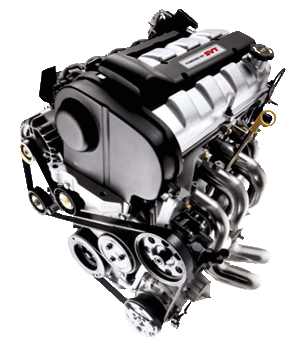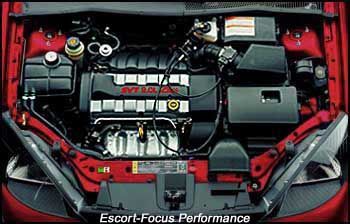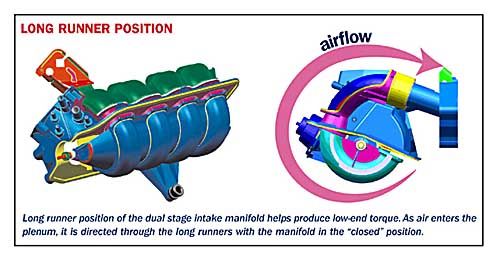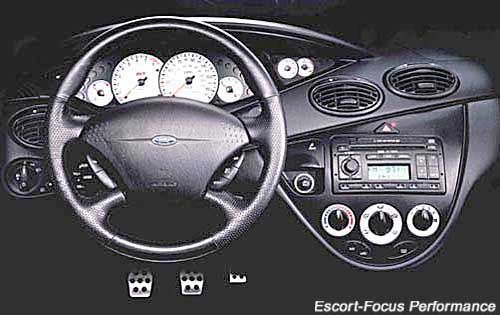| To
meet the Special Vehicle Team's handling, braking, and steering objectives, all aspects of the car's chassis systems were analyzed to determine where modifications were necessary. The single most dramatic development is in the braking system, which gives the car extraordinary stopping capability. The SVT Focus is equipped with four-wheel disc brakes with an anti-lock system, the rear disc system coming from European models. The front brake rotors are 300mm (11.8 inches) in diameter,
compared with 258mm (10.1 inches) on the ZX3. Upsized single-piston calipers are used to fit these much larger front rotors. The rear brake rotors are 280mm in diameter. In the front and rear suspension systems, higher spring rates, larger stabilizer bars, and special shock-valve tuning combine to give the car taut, precise handling and SVT's hallmark compliant ride. To grip the road and enhance its dynamic appearance, the SVT Focus sports 17x7-inch,
five-spoke alloy wheels fitted with 215/45ZR-17 tires. This car corners like it's on rails able to do a .91g on a 300' skidpad. |
| The SVT Focus follows the Special Vehicle Team's design philosophy, which is to create subtle but distinctive appearance changes that will make the vehicle stand out, especially among enthusiasts, as an SVT product. The car has new fascias front and rear, along with new rocker moldings and a rear spoiler mounted on the liftgate. SVT-signature crystalline round fog lamps are set in the lower
front fascia. The upper and lower front grilles and rear valence grille are done in a black honeycomb design. The headlights receive a smoked-glass look. The larger diameter exhaust pipe is accented with a polished chrome tip at the rear. "These exterior changes, including its very distinctive 17-inch wheels, really give the car the appearance of having a lower, wider stance and lots of rubber on the ground," Slankard adds. |
| Inside, significant changes and improvements are designed to enhance the driving environment, in terms of both ergonomics and appearance. All the driver's "touch zones" have received attention. New elements unique to the SVT Focus
include metallic pedal covers to facilitate heel-and-toe downshifting, a metallic dead pedal, a black leather-wrapped parking brake lever with a satin aluminum release button, and a black leather-wrapped aluminum shift knob and steering wheel. The front seats are six-way adjustable. This includes a rotary recliner mechanism, manual fore/aft movement, and standard power up/down adjustment system.
All seats are black leather trim with either red or blue cloth inserts, and the front seats
have added foam pads and frame wires to substantially increase lateral support. The unique SVT Focus seat trim continues into the rear seat as well. The seat is a 60/40 split with folding back, flip-up cushion, as well as left, right and center head restraints.
The instrument cluster puts the car unmistakably in the SVT family, with titanium-faced electro-luminescent gauges, including tachometer and 160 mph speedometer, and a black center stack with silver climate control bezels.
Additional gauges on the SVT Focus include oil temperature and oil pressure in place of a coin storage compartment on the ZX3 model.
SVT Focus exterior color choices for 2002 are Sonic Blue, Infra-Red, CD Silver, and Pitch Black. Two interior colors are available to complement the black leather seat bolsters and head restraints. Red or blue cloth is available to accent the seat backs, seat cushions and door-trim panels. |






